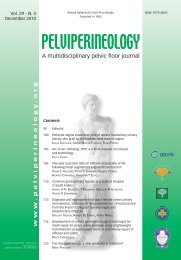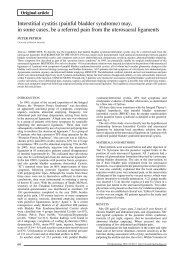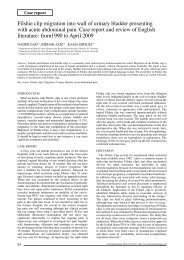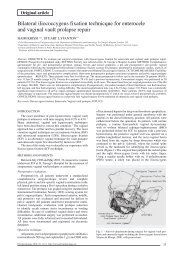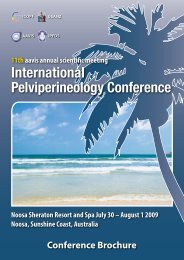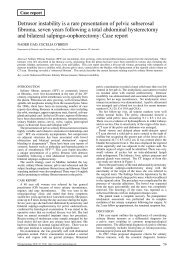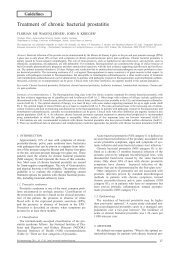This Issue Complete PDF - Pelviperineology
This Issue Complete PDF - Pelviperineology
This Issue Complete PDF - Pelviperineology
Create successful ePaper yourself
Turn your PDF publications into a flip-book with our unique Google optimized e-Paper software.
A preliminary report on the use of a partially absorbable mesh in pelvic reconstructive surgery<br />
Fig. 1. – Cross section of partially absorbable Seramesh PA ® and<br />
Seragyn ® PFI thread with six filaments of PP and a coat of polyglycolacid<br />
and -caprolacton (scanning electron microscope). The<br />
distance between the PP- filaments is > 10 m.<br />
Fig. 2. – Histologic section of Seramesh PA ® and Seragyn ® PFI<br />
thread 120 days after implantation in rat tissue. The hexafilament<br />
profile of PP persists after absorption of the co- polymer of PGA and<br />
PCL.<br />
4. Davila GW, Drutz H, Deprest J. Clinical implications of the<br />
biology of grafts: conclusions of the 2005 IUGA grafts roundtable.<br />
Int Urogynecol J 2006; 17: 51-55.<br />
5. Bump RC, Mattiason A, Bo K, et al. The standardization of<br />
terminology of female pelvic organ prolapse and pelvic floor<br />
dysfunction. Am J Obstet Gynecol 1996; 175: 10-17.<br />
6. Fischer A. Die Technik der transobturatoriellen 4-Punkt und<br />
der 6- Punkt Fixierung. In: Praktische Urogynäkologie-spannungsfrei.<br />
Haag + Herchen. Frankfurt a. M. 2006; 104-108.<br />
7. Scheidbach H, Tamme C, Tannapfel A, et al. In vivo studies<br />
comparing the biocompatibility of various polypropylene<br />
meshes and their handling properties during endoscopic total<br />
extraperitoneal (TEP) patchplasty: an experimental study in<br />
pigs. Surgical Endoscopy 2004; 10: 211-220.<br />
8. Amid PK, Shulman AG, Lichtenstein IL, Hakakha M. Biomaterials<br />
for abdominal wall hernia surgery and principles of their<br />
applications. Langenbecks Arch Chir 1994; 379: 168- 171.<br />
9. Collinet P, Belot F, Debodinance P, et al. Transvaginal mesh<br />
technique for pelvic organ prolapse repair: mesh exposure<br />
management and risk factors. Int Urogynecol J 2006; 17: 315-<br />
320.<br />
10. Neumann M, Lavy Y. Reducing mesh exposure in posterior<br />
intra vaginal slingplasty (PIVS) for vaginal apex suspension.<br />
<strong>Pelviperineology</strong> 2007; 26: 117-120.<br />
11. Achtari C, Hiscock R, Reilly BAO, et al. Risk factors for<br />
mesh erosion after transvaginal surgery using polypropylene<br />
(Atrium) or composite polypropylene/polyglactin 910 (Vypro<br />
II) mesh. Intern Urogyn J Floor Dysfunct 2005; 16: 389- 394.<br />
12. Deffieux X, de Tayrac R, Huel C, et al. Vaginal mesh<br />
erosion after transvaginal repair of cystocele using Gynemesh<br />
or Gynemesh-Soft in 138 women: a comparative study. Int<br />
Urogyn J 2007; 18: 73-79.<br />
13. Nazemi Tanya M, Kobashi KC. Complications of grafts used in<br />
female pelvic floor reconstruction: mesh erosion and extrusion.<br />
Indian J Urology 2007; 23: 153-160.<br />
14. Julian TM. The efficacy of Marlex mesh in the repair of severe<br />
recurrent vaginal prolapse of the anterior midvaginal wall. Am<br />
J Obstet Gynecol 1996; 175: 1472-1475.<br />
Interests Declared:<br />
– The authors state that there are no grants, pecuniary interests or<br />
financial support in relation to this study.<br />
– The author OG is a textile engineer. As an employee at<br />
SERAG- WIESSNER KG. He declares his pecuniary and commercial<br />
interests.<br />
Fig. 3. – Weight of different meshes in g/m 2 .<br />
Correspondence to:<br />
Dr. ACHIM NIESEL<br />
Klinik Preetz, Department for Obstetrics and Gynecology,<br />
Am Krankenhaus 5, 24211 Preetz, Germany,<br />
Tel. 04342 801200, Fax. 04342 801258<br />
Email: a.niesel@klinik-preetz.de<br />
Pelvic Floor Digest<br />
continued from page 21<br />
National trends and costs of surgical treatment for female fecal incontinence. Sung VW, Rogers ML, Myers DL et al. Am J Obstet Gynecol.<br />
2007;197:652. <strong>This</strong> study describes national trends, hospital charges, and costs of inpatient surgical treatment for female fecal incontinence in<br />
the United States. From 1998 to 2003 21,547 women underwent inpatient surgery for fecal incontinence. <strong>This</strong> number has remained stable,<br />
with 3423 procedures in 1998 and 3509 procedures in 2003. The overall risk of complications was 15.4% and the risk of death was 0.02%.<br />
Total charges increased from $34 million in 1998 to $57.5 million in 2003, a significant economic impact on the health care system.<br />
Prevalence and risk factors of fecal incontinence (FI) in women undergoing stress incontinence (IU) surgery. Markland AD, Kraus SR,<br />
Richter HE. Am J Obstet Gynecol. 2007;197:662. Women enrolled in a stress UI surgical trial have high rates of FI. Potential risk factors<br />
for (at least) monthly fecal incontinence (FI) in women presenting for stress urinary incontinence (UI) surgery are decreased anal sphincter<br />
contraction, perimenopausal status, prior incontinence surgery/treatment, and increased UI bother.<br />
The PFD continues on page 27<br />
25



